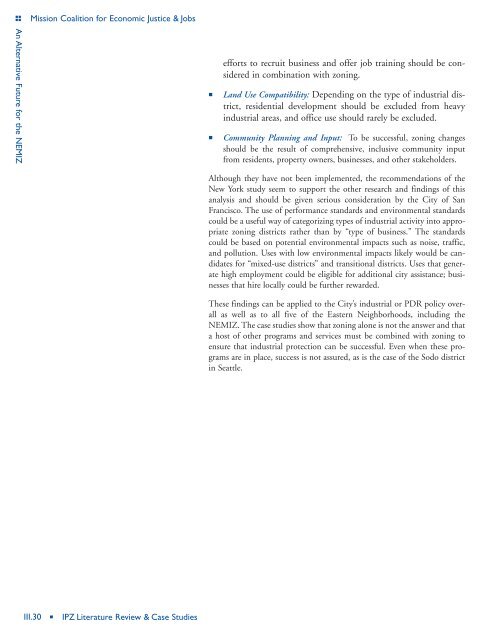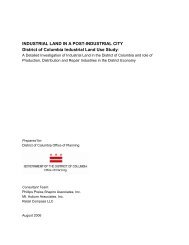An Alternative Future for the North East Mission Industrial Zone
An Alternative Future for the North East Mission Industrial Zone
An Alternative Future for the North East Mission Industrial Zone
You also want an ePaper? Increase the reach of your titles
YUMPU automatically turns print PDFs into web optimized ePapers that Google loves.
<strong>An</strong> <strong>Alternative</strong> <strong>Future</strong> <strong>for</strong> <strong>the</strong> NEMIZ<br />
<strong>Mission</strong> Coalition <strong>for</strong> Economic Justice & Jobs<br />
III.30 IPZ Literature Review & Case Studies<br />
ef<strong>for</strong>ts to recruit business and offer job training should be considered<br />
in combination with zoning.<br />
Land Use Compatibility: Depending on <strong>the</strong> type of industrial district,<br />
residential development should be excluded from heavy<br />
industrial areas, and office use should rarely be excluded.<br />
Community Planning and Input: To be successful, zoning changes<br />
should be <strong>the</strong> result of comprehensive, inclusive community input<br />
from residents, property owners, businesses, and o<strong>the</strong>r stakeholders.<br />
Although <strong>the</strong>y have not been implemented, <strong>the</strong> recommendations of <strong>the</strong><br />
New York study seem to support <strong>the</strong> o<strong>the</strong>r research and findings of this<br />
analysis and should be given serious consideration by <strong>the</strong> City of San<br />
Francisco. The use of per<strong>for</strong>mance standards and environmental standards<br />
could be a useful way of categorizing types of industrial activity into appropriate<br />
zoning districts ra<strong>the</strong>r than by “type of business.” The standards<br />
could be based on potential environmental impacts such as noise, traffic,<br />
and pollution. Uses with low environmental impacts likely would be candidates<br />
<strong>for</strong> “mixed-use districts” and transitional districts. Uses that generate<br />
high employment could be eligible <strong>for</strong> additional city assistance; businesses<br />
that hire locally could be fur<strong>the</strong>r rewarded.<br />
These findings can be applied to <strong>the</strong> City’s industrial or PDR policy overall<br />
as well as to all five of <strong>the</strong> <strong>East</strong>ern Neighborhoods, including <strong>the</strong><br />
NEMIZ. The case studies show that zoning alone is not <strong>the</strong> answer and that<br />
a host of o<strong>the</strong>r programs and services must be combined with zoning to<br />
ensure that industrial protection can be successful. Even when <strong>the</strong>se programs<br />
are in place, success is not assured, as is <strong>the</strong> case of <strong>the</strong> Sodo district<br />
in Seattle.












